Abstract
We have determined the amino acid sequence of the first constant (C) region domain (C delta 1) and the hinge region of the delta heavy chain of human IgD WAH and also the sequence of the adjacent COOH-terminal portion of the variable (V) region, including the JH region. Together with the sequence of the Fc fragment already reported, this establishes the complete amino acid sequence of the C region of the human delta chain and confirms the presence of three C region domains in human IgD. Although the CH1 domains of the five classes of human heavy chains have the expected degree of homology (approximately 30%), the homology of the C delta 1 domains of the human and mouse chains is less than that exhibited by the CH1 domains of other pairs of human and mouse heavy chains. The hinge region of the human delta chain has an unusual structure; the NH2-terminal half has four (or five) GalN oligosaccharides attached, whereas the COOH-terminal half lacks carbohydrate, is dissimilar in sequence, and has a high charge. A computer search verified that the GalN-rich segment has a high degree of identity in sequence with the middle portion of the human C mu 2 domain and that the high-charge segment is related to the same sequence. We propose that the two segments of the human delta hinge have a common evolutionary origin and arose by duplication and independent mutation of a hinge exon derived from the ancestral gene for the C mu 2 domain.
Full text
PDF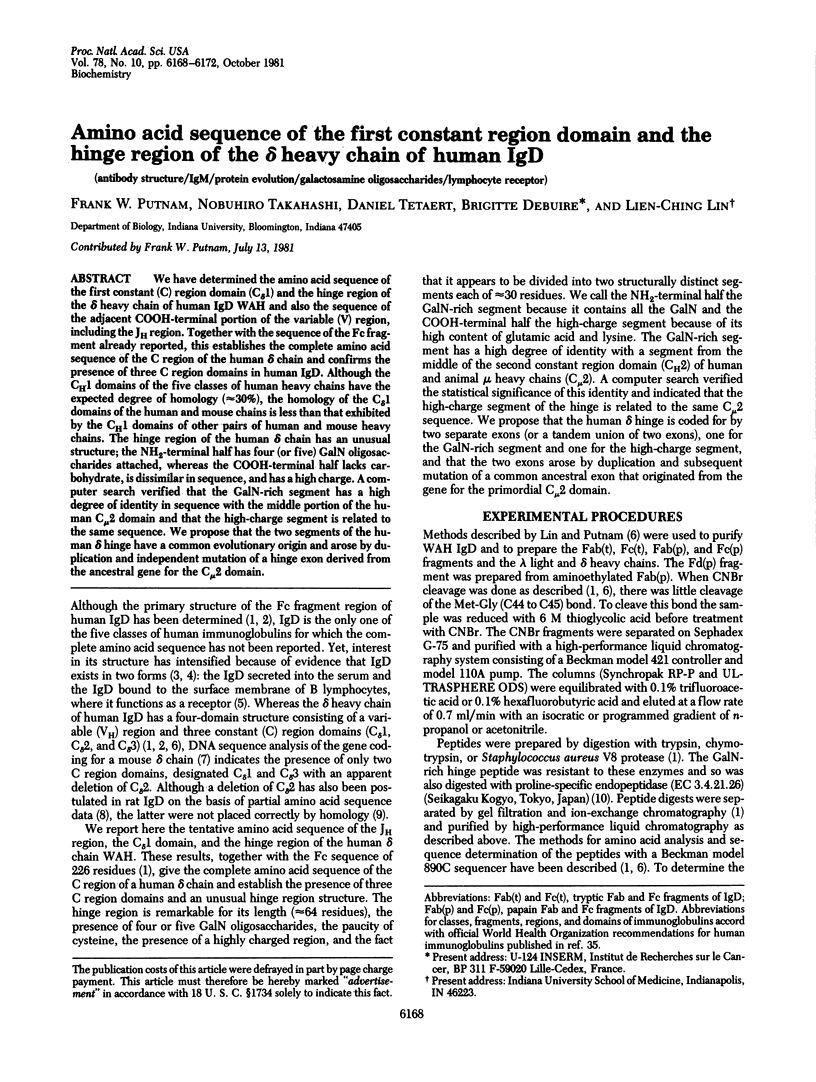
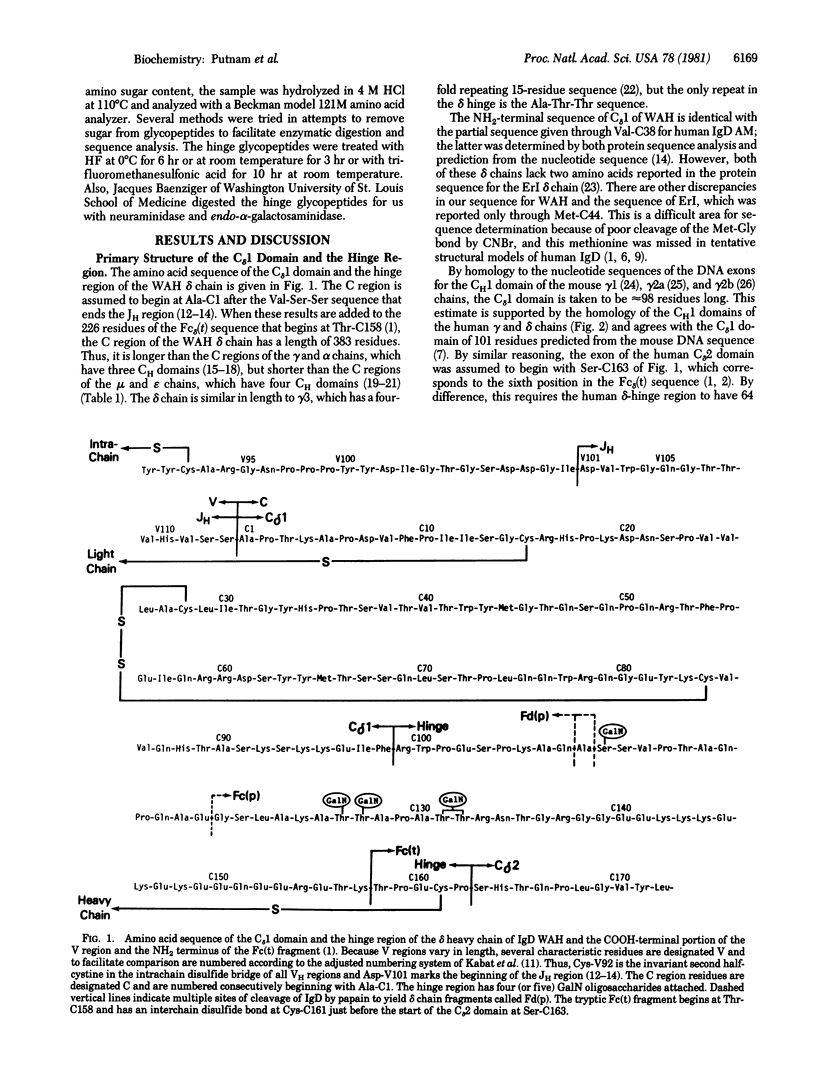
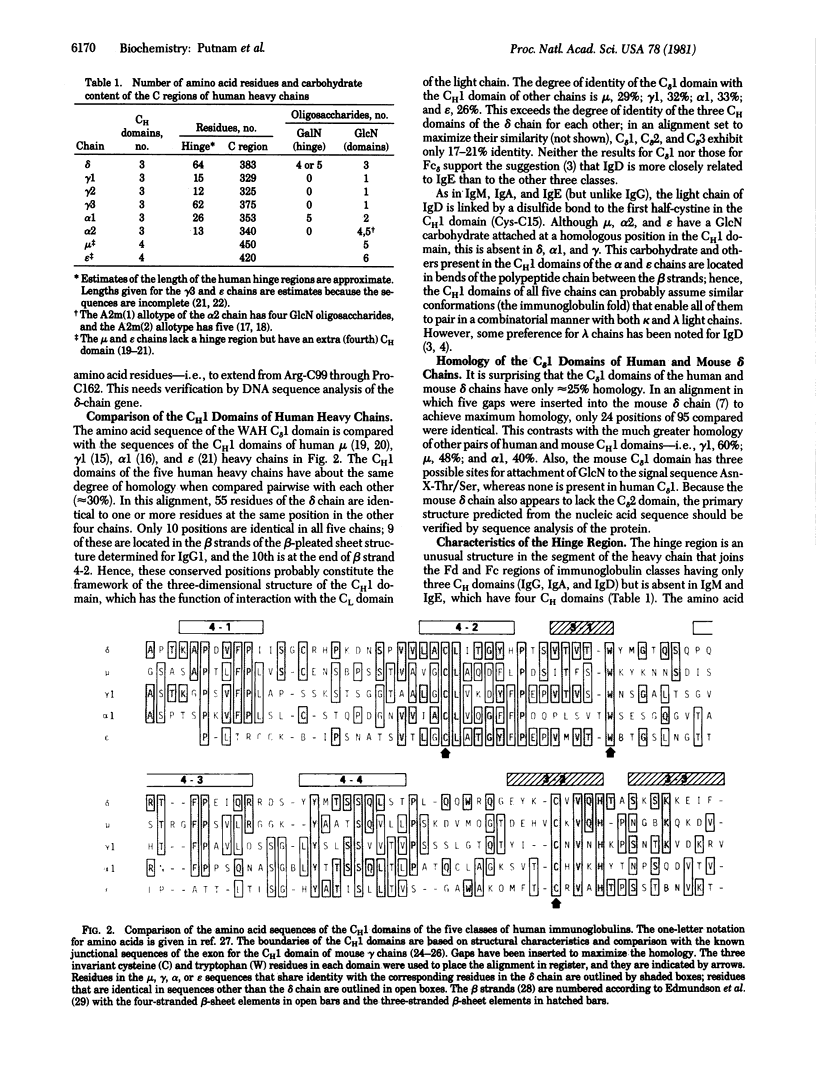
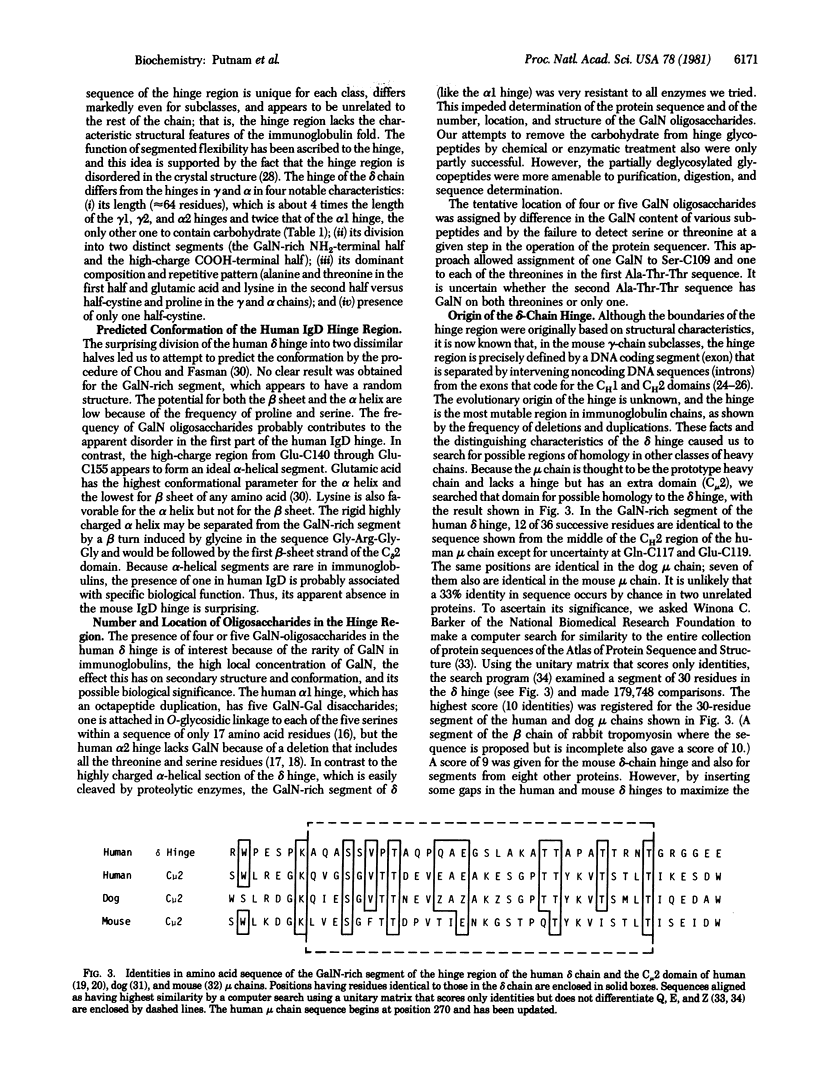
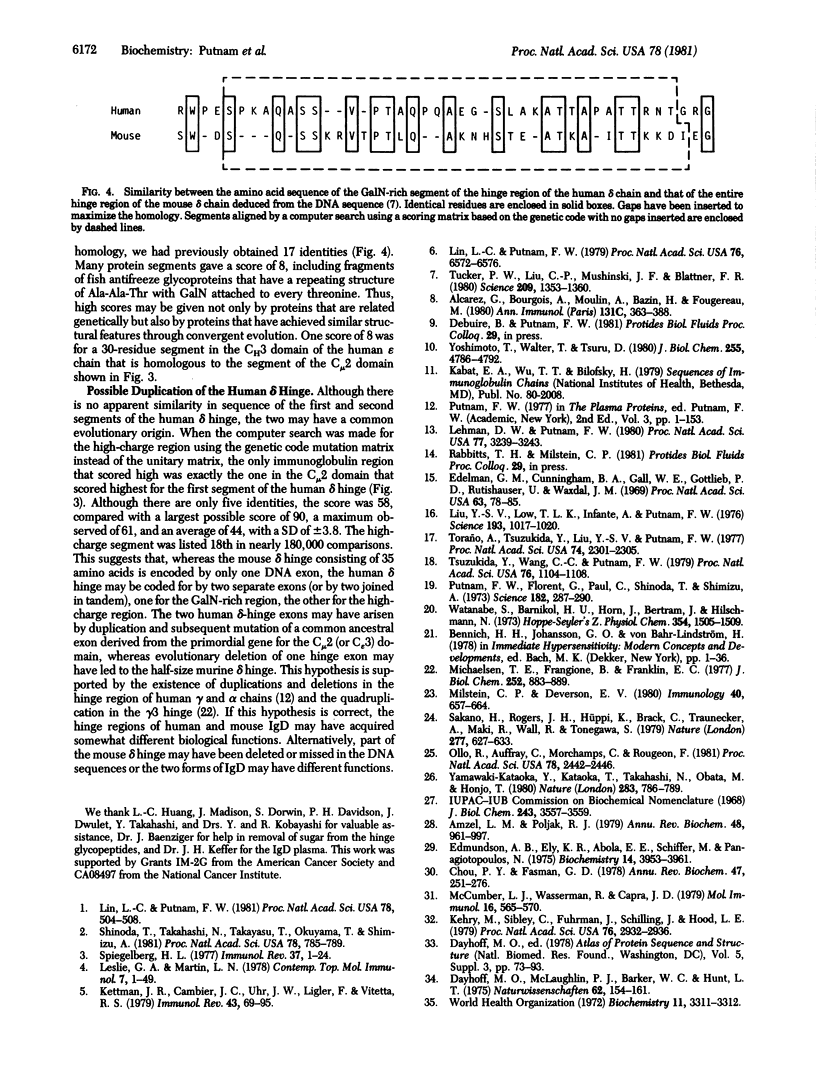
Images in this article
Selected References
These references are in PubMed. This may not be the complete list of references from this article.
- Alcaraz G., Bourgois A., Moulin A., Bazin H., Fougereau M. Partial structure of a rat IgD molecule with a deletion in the heavy chain. Ann Immunol (Paris) 1980 May-Jun;131C(3):363–388. [PubMed] [Google Scholar]
- Amzel L. M., Poljak R. J. Three-dimensional structure of immunoglobulins. Annu Rev Biochem. 1979;48:961–997. doi: 10.1146/annurev.bi.48.070179.004525. [DOI] [PubMed] [Google Scholar]
- Chou P. Y., Fasman G. D. Empirical predictions of protein conformation. Annu Rev Biochem. 1978;47:251–276. doi: 10.1146/annurev.bi.47.070178.001343. [DOI] [PubMed] [Google Scholar]
- Edelman G. M., Cunningham B. A., Gall W. E., Gottlieb P. D., Rutishauser U., Waxdal M. J. The covalent structure of an entire gammaG immunoglobulin molecule. Proc Natl Acad Sci U S A. 1969 May;63(1):78–85. doi: 10.1073/pnas.63.1.78. [DOI] [PMC free article] [PubMed] [Google Scholar]
- Kehry M., Sibley C., Fuhrman J., Schilling J., Hood L. E. Amino acid sequence of a mouse immunoglobulin mu chain. Proc Natl Acad Sci U S A. 1979 Jun;76(6):2932–2936. doi: 10.1073/pnas.76.6.2932. [DOI] [PMC free article] [PubMed] [Google Scholar]
- Kettman J. R., Cambier J. C., Uhr J. W., Ligler F., Vitetta E. S. The role of receptor IgM and IgD in determining triggering and induction of tolerance in murine B cells. Immunol Rev. 1979;43:69–95. doi: 10.1111/j.1600-065x.1979.tb00418.x. [DOI] [PubMed] [Google Scholar]
- Lehman D. W., Putnam F. W. Amino acid sequence of the variable region of a human mu chain: location of a possible JH segment. Proc Natl Acad Sci U S A. 1980 Jun;77(6):3239–3243. doi: 10.1073/pnas.77.6.3239. [DOI] [PMC free article] [PubMed] [Google Scholar]
- Leslie G. A., Martin L. N. Structure and function of serum and membrane immunoglobulin D (IgD). Contemp Top Mol Immunol. 1978;7:1–49. doi: 10.1007/978-1-4757-0779-3_1. [DOI] [PubMed] [Google Scholar]
- Lin L. C., Putnam F. W. Primary structure of the Fc region of human immunoglobulin D: implications for evolutionary origin and biological function. Proc Natl Acad Sci U S A. 1981 Jan;78(1):504–508. doi: 10.1073/pnas.78.1.504. [DOI] [PMC free article] [PubMed] [Google Scholar]
- Lin L. C., Putnam F. W. Structural studies of human IgD: isolation by a two-step purification procedure and characterization by chemical and enzymatic fragmentation. Proc Natl Acad Sci U S A. 1979 Dec;76(12):6572–6576. doi: 10.1073/pnas.76.12.6572. [DOI] [PMC free article] [PubMed] [Google Scholar]
- Liu Y. S., Low T. L., Infante A., Putnam F. W. Complete covalent structure of a human IgA1 immunoglobulin. Science. 1976 Sep 10;193(4257):1017–1020. doi: 10.1126/science.821146. [DOI] [PubMed] [Google Scholar]
- McCumber L. J., Capra J. D. The complete amino-acid sequence of a canine mu chain. Mol Immunol. 1979 Aug;16(8):565–570. doi: 10.1016/0161-5890(79)90119-6. [DOI] [PubMed] [Google Scholar]
- Michaelsen T. E., Frangione B., Franklin E. C. Primary structure of the "hinge" region of human IgG3. Probable quadruplication of a 15-amino acid residue basic unit. J Biol Chem. 1977 Feb 10;252(3):883–889. [PubMed] [Google Scholar]
- Milstein C. P., Deverson E. V. J segment in human delta chains. Immunology. 1980 Aug;40(4):657–664. [PMC free article] [PubMed] [Google Scholar]
- Ollo R., Auffray C., Morchamps C., Rougeon F. Comparison of mouse immunoglobulin gamma 2a and gamma 2b chain genes suggests that exons can be exchanged between genes in a multigenic family. Proc Natl Acad Sci U S A. 1981 Apr;78(4):2442–2446. doi: 10.1073/pnas.78.4.2442. [DOI] [PMC free article] [PubMed] [Google Scholar]
- Putnam F. W., Florent G., Paul C., Shinoda T., Shimizu A. Complete amino acid sequence of the Mu heavy chain of a human IgM immunoglobulin. Science. 1973 Oct 19;182(4109):287–291. doi: 10.1126/science.182.4109.287. [DOI] [PubMed] [Google Scholar]
- Sakano H., Rogers J. H., Hüppi K., Brack C., Traunecker A., Maki R., Wall R., Tonegawa S. Domains and the hinge region of an immunoglobulin heavy chain are encoded in separate DNA segments. Nature. 1979 Feb 22;277(5698):627–633. doi: 10.1038/277627a0. [DOI] [PubMed] [Google Scholar]
- Shinoda T., Takahashi N., Takayasu T., Okuyama T., Shimizu A. Complete amino acid sequence of the Fc region of a human delta chain. Proc Natl Acad Sci U S A. 1981 Feb;78(2):785–789. doi: 10.1073/pnas.78.2.785. [DOI] [PMC free article] [PubMed] [Google Scholar]
- Spiegelberg H. L. The structure and biology of human IgD. Immunol Rev. 1977;37:3–24. doi: 10.1111/j.1600-065x.1977.tb00243.x. [DOI] [PubMed] [Google Scholar]
- Toraño A., Tsuzukida Y., Liu Y. S., Putnam F. W. Location and structural significance of the oligosaccharides in human Ig-A1 and IgA2 immunoglobulins. Proc Natl Acad Sci U S A. 1977 Jun;74(6):2301–2305. doi: 10.1073/pnas.74.6.2301. [DOI] [PMC free article] [PubMed] [Google Scholar]
- Tsuzukida Y., Wang C. C., Putnam F. W. Structure of the A2m(1) allotype of human IgA--a recombinant molecule. Proc Natl Acad Sci U S A. 1979 Mar;76(3):1104–1108. doi: 10.1073/pnas.76.3.1104. [DOI] [PMC free article] [PubMed] [Google Scholar]
- Tucker P. W., Liu C. P., Mushinski J. F., Blattner F. R. Mouse immunoglobulin D: messenger RNA and genomic DNA sequences. Science. 1980 Sep 19;209(4463):1353–1360. doi: 10.1126/science.6968091. [DOI] [PubMed] [Google Scholar]
- Watanabe S., Barnikol H. U., Horn J., Bertram J., Hilschmann N. Die Primärstruktur eines monoklonalen IgM-Immunoglobulins (Makroglobulin Gal.), II. Die Aminosäuresequenz der H-Kette (mu-Typ,Subgruppe HIII), Struktur des gesamten IgM-Moleküls. Hoppe Seylers Z Physiol Chem. 1973 Oct-Nov;354(10-11):1505–1509. [PubMed] [Google Scholar]
- Yamawaki-Kataoka Y., Kataoka T., Takahashi N., Obata M., Honjo T. Complete nucleotide sequence of immunoglobulin gamma2b chain gene cloned from newborn nouse DNA. Nature. 1980 Feb 21;283(5749):786–789. doi: 10.1038/283786a0. [DOI] [PubMed] [Google Scholar]
- Yoshimoto T., Walter R., Tsuru D. Proline-specific endopeptidase from Flavobacterium. Purification and properties. J Biol Chem. 1980 May 25;255(10):4786–4792. [PubMed] [Google Scholar]



